Alligators and Turtles in Southeastern Texas
I started thinking about Softshell Turtles when I was writing about the Red-eared Slider Turtles with possible Alligator tooth marks on them. If the marks on the shells of Sliders really were toothmarks, then how on Earth do Softshell Turtles coexist…
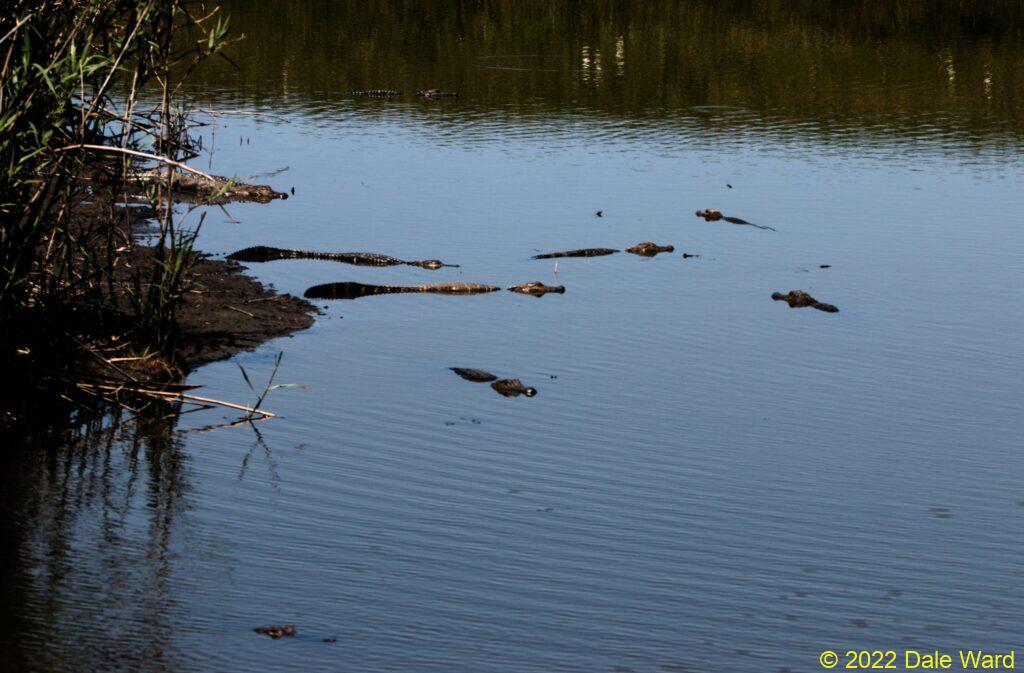 Group of Alligators at Anahuac National Wildlife Refuge, Texas. There were a lot of Alligators here - I see nine in this shot. Some of the smaller objects in the water are Turtles hovering just below the surface of the water, sticking their snouts up into the air like snorkels.
Group of Alligators at Anahuac National Wildlife Refuge, Texas. There were a lot of Alligators here - I see nine in this shot. Some of the smaller objects in the water are Turtles hovering just below the surface of the water, sticking their snouts up into the air like snorkels.
Of all the creatures that we were hoping to see on our recent trip to Southeastern Texas, Alligators were near the top of the list. Luckily for us, the Herpetological Gods smiled and showed us a lot of Alligators.
We also saw a lot of Turtles - mostly Red-eared Sliders (Trachemys scripta elegans). These Turtles are popular in the pet trade and have been introduced all over the United States. They’re native Turtles in Southeastern Texas, though.
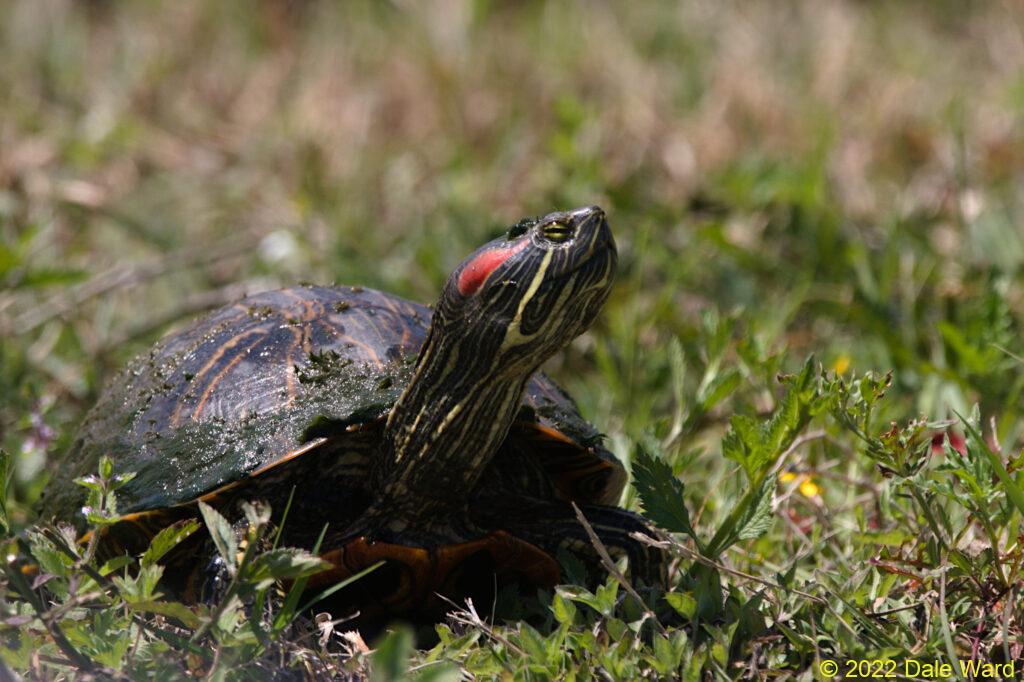 Red-eared Slider (_Trachemys scripta elegans_) walking on the canal bank at Anahuac National Wildlife Refuge
Red-eared Slider (_Trachemys scripta elegans_) walking on the canal bank at Anahuac National Wildlife Refuge
The Turtles and the Alligators were intermixed. If we saw Alligators, there was a good chance that we’d also see Turtles.
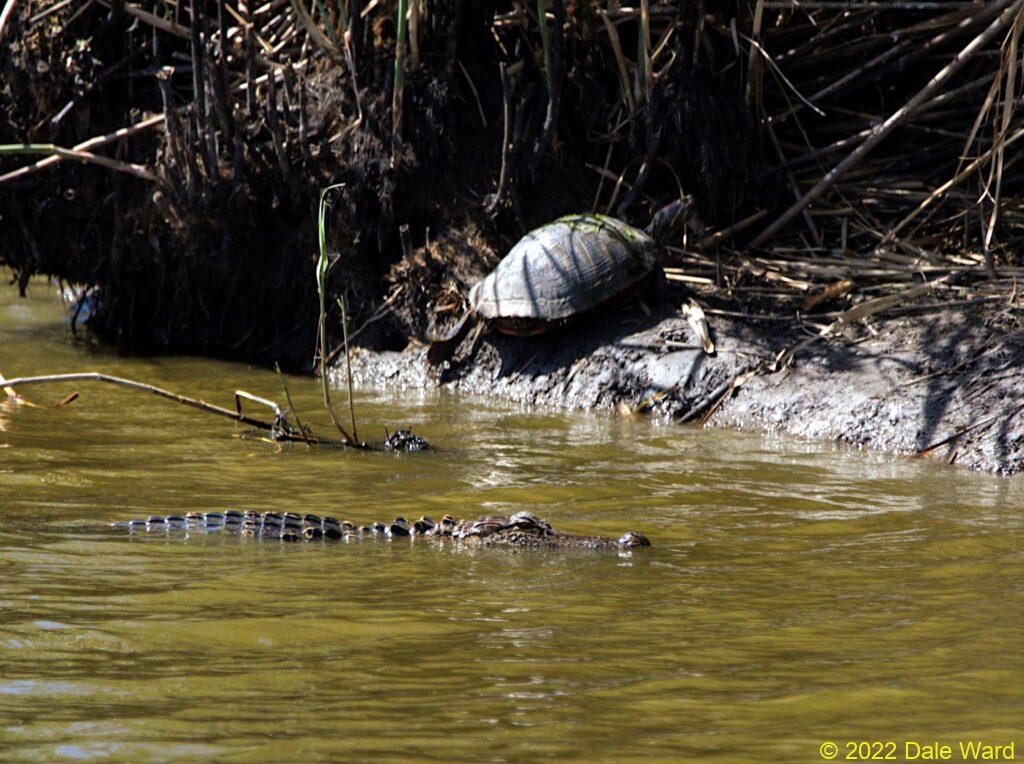 Red-eared Slider (_Trachemys scripta elegans_) on a canal bank at Anahuac National Wildlife Refuge, Texas, with an Alligator floating nearby.
Red-eared Slider (_Trachemys scripta elegans_) on a canal bank at Anahuac National Wildlife Refuge, Texas, with an Alligator floating nearby.
It surprised me to regularly see Alligators and Turtles so close together. I was always under the impression that Alligators ate Turtles.
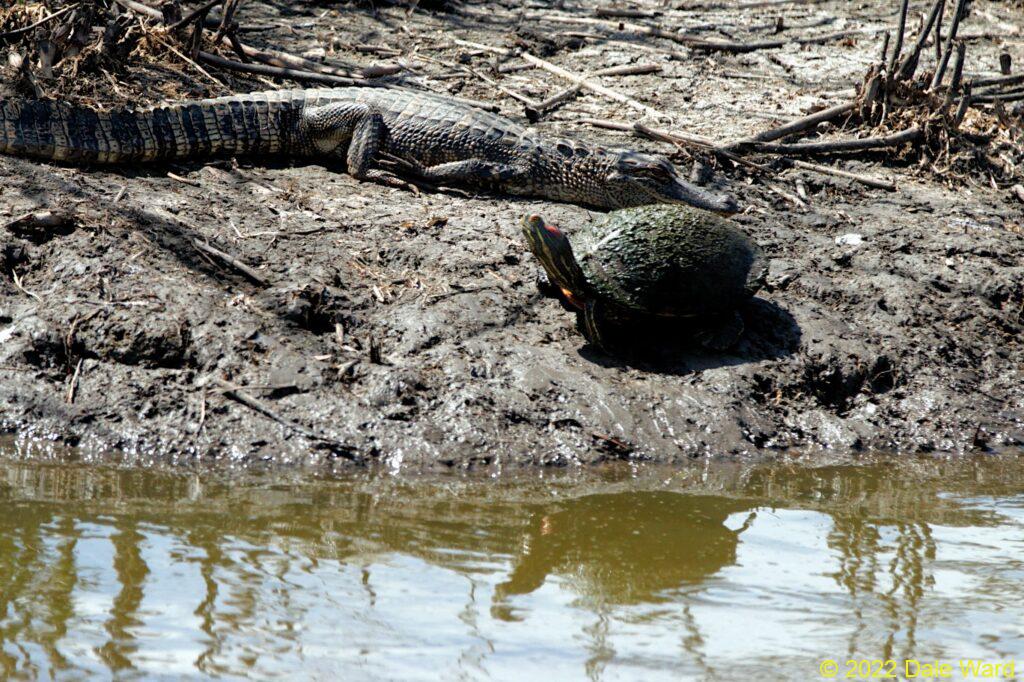 Red-eared Slider (_Trachemys scripta elegans_) near a small sunning Alligator at Anahuac. It’s neat to see the slide marks in the mud left by the Turtles and Alligators.
Red-eared Slider (_Trachemys scripta elegans_) near a small sunning Alligator at Anahuac. It’s neat to see the slide marks in the mud left by the Turtles and Alligators.
When we visited the Houston Audubon’s Smith Oaks Rookery on High Island, the boardwalks over the water let us look down onto the Turtles from above. That let me get photographs of the Turtles from a high angle, getting a much better view of their shells.
I didn’t notice it at the time, but when I downloaded the Turtle images and looked more closely, I could see what might be scarring from unsuccessful Alligator feeding attempts.
Here’s what I mean. Look at the round lesions on this Turtle’s shell:
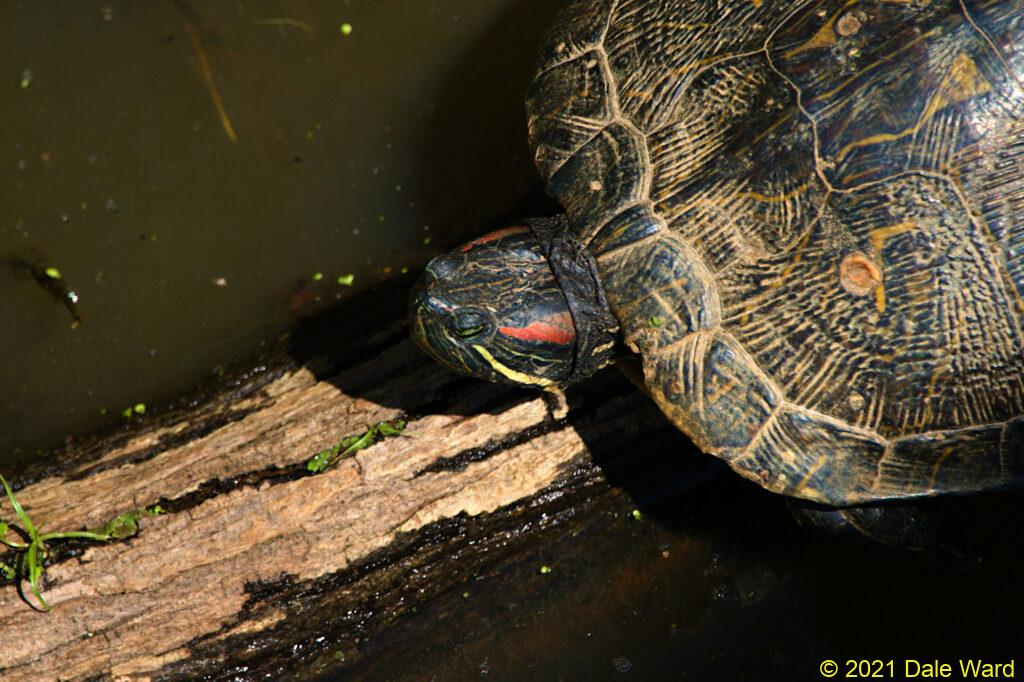 Red-Eared Slider _(Trachemys scripta elegans_) with possible tooth-scarring on the shell
Red-Eared Slider _(Trachemys scripta elegans_) with possible tooth-scarring on the shell
Here’s the same view, but with red arrows pointing to the round lesions I’m talking about.
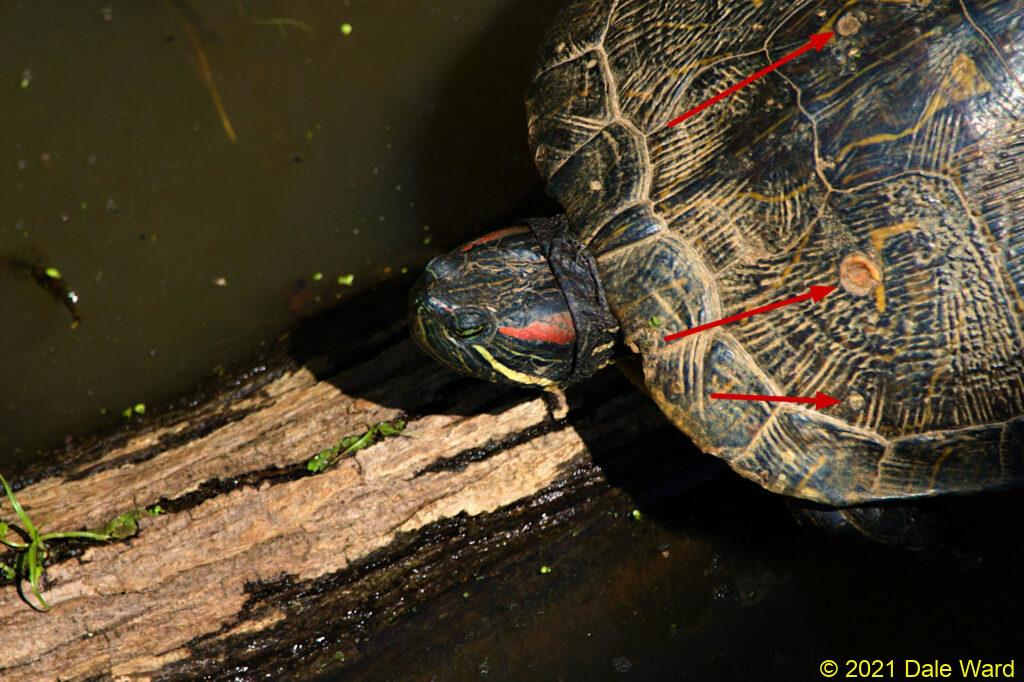 Red-Eared Slider (_Trachemys scripta elegans_) with possible tooth-scarring on the shell, indicated by red arrows.
Red-Eared Slider (_Trachemys scripta elegans_) with possible tooth-scarring on the shell, indicated by red arrows.
Those round lesions could be toothmarks, scarring from an Alligator attack. Notice the way the lesions are arranged in a line - the teeth in an Alligator’s jaw would be more-or-less in a line, also.
Also, note the way the lowest shell marking in the photo is faintest. Perhaps the curve of the shell meant that most of the bite pressure was at the upper two marks, and there was not a lot of pressure on the lower spot?
Here are a couple of closer views of the same Turtle’s shell. I can see what I think might be additional lesions, along the same line as the first.
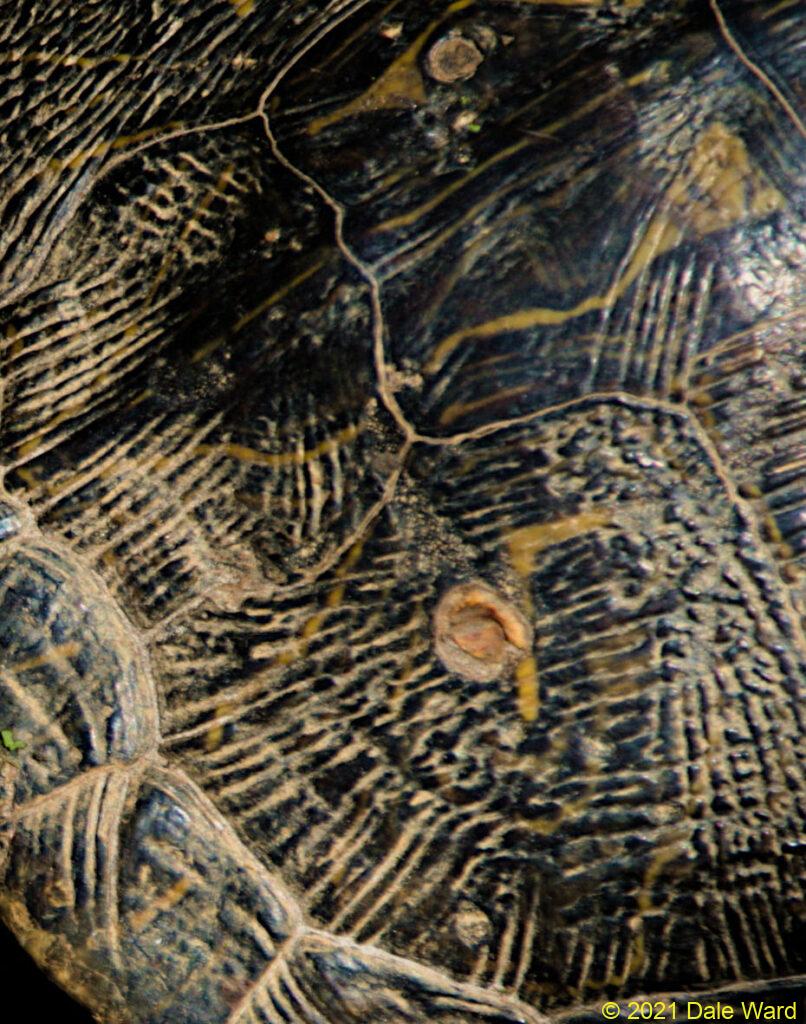 Red-Eared Slider (_Trachemys scripta elegans_) - closeup of possible tooth-scarring on the shell
Red-Eared Slider (_Trachemys scripta elegans_) - closeup of possible tooth-scarring on the shell
Also, there are small chips around the two upper-most arrowed lesions in the photo below. These might have been marks left by the Gator’s teeth as the Gator shifted the Turtle around in its bite, trying to get better purchase on the shell.
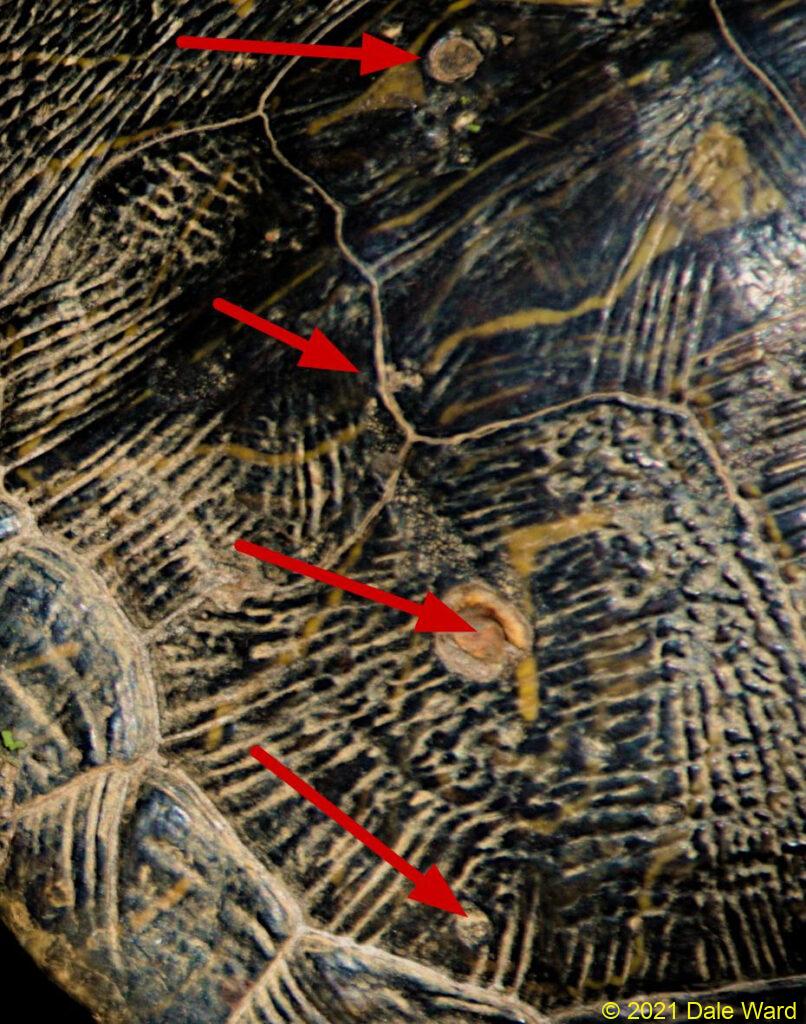 Red-Eared Slider (_Trachemys scripta elegans_) - closeup of possible tooth-scarring on the shell, marked with red arrows.
Red-Eared Slider (_Trachemys scripta elegans_) - closeup of possible tooth-scarring on the shell, marked with red arrows.
Below is another Red-eared Slider from Smith Rookery, showing similar marks on his shell.
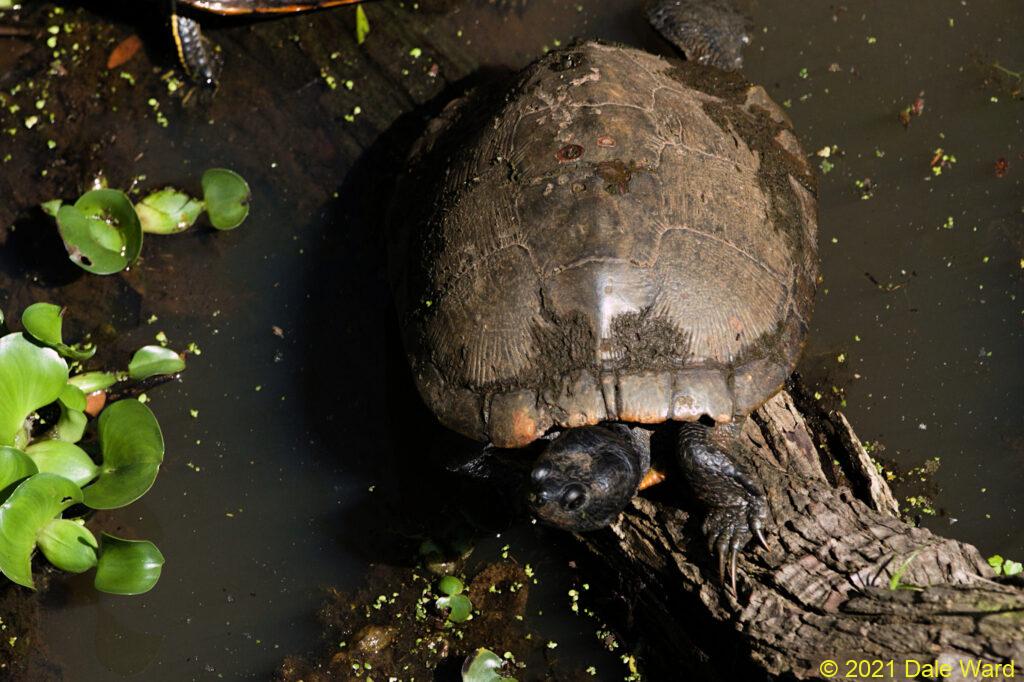 Red-Eared Slider (_Trachemys scripta elegan_s) with possible tooth-scarring on the shell
Red-Eared Slider (_Trachemys scripta elegan_s) with possible tooth-scarring on the shell
Here’s the same photo, but with red arrows pointing to the marks I’m talking about:
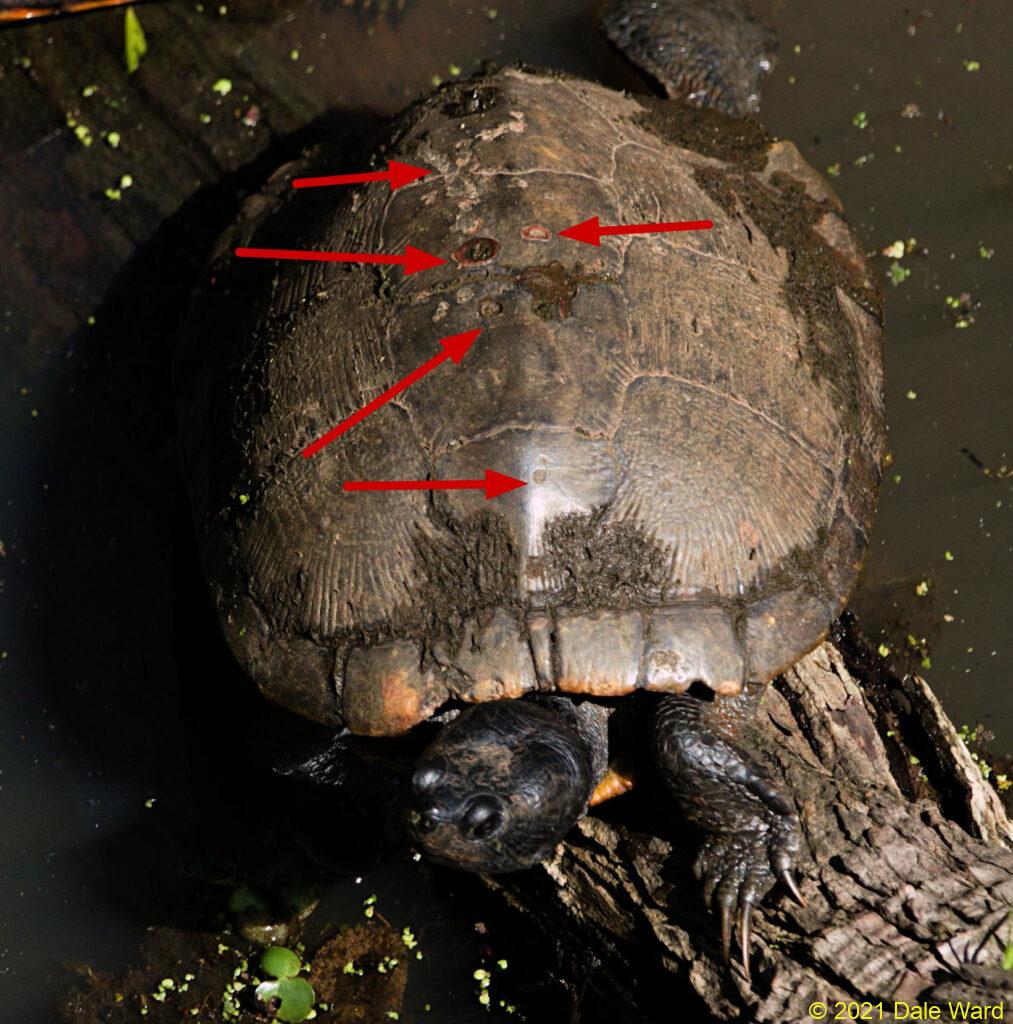 Red-Eared Slider (_Trachemys scripta elegans_) with possible tooth-scarring on the shell, marked with red arrows
Red-Eared Slider (_Trachemys scripta elegans_) with possible tooth-scarring on the shell, marked with red arrows
And finally, a third Red-eared slider from the same Smith Rookery pool.
The marks on this Turtle’s shell are different than marks on the other Turtle shells. These shell marks are not circular, as were the marks in the previous photos.
Rather, these marks look like rake drag, or scrape, marks.
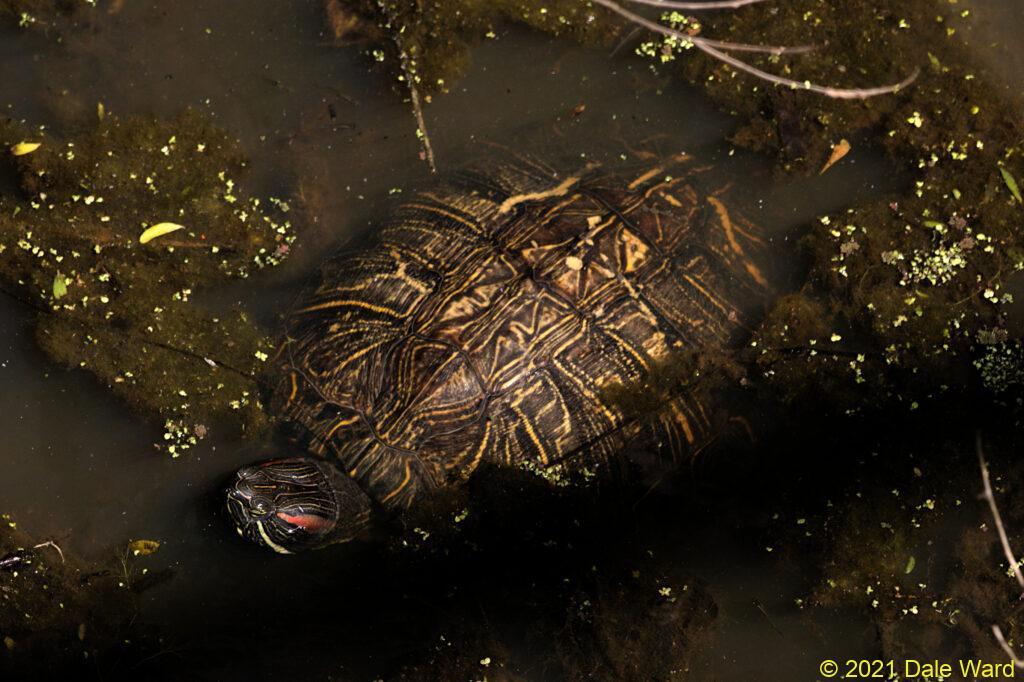 Red-Eared Slider (_Trachemys scripta elegans_) with possible tooth-scarring on the shell
Red-Eared Slider (_Trachemys scripta elegans_) with possible tooth-scarring on the shell
Here’s the same ‘drag mark’ turtle photo, with red arrows indicating the scrape marks I’m talking about.
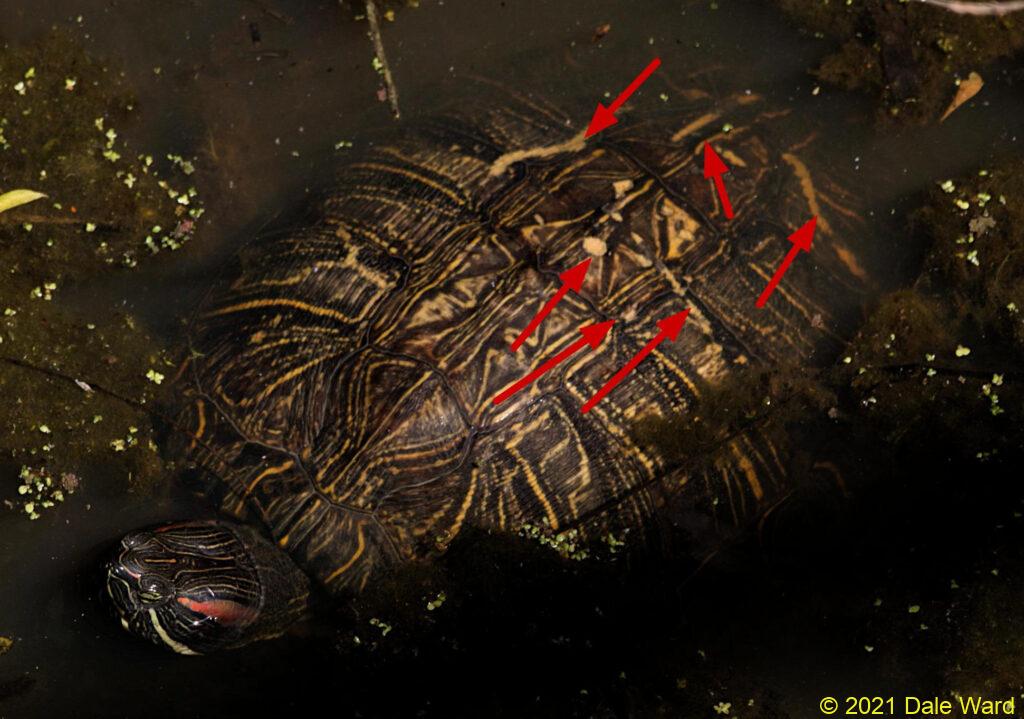 Red-Eared Slider (_Trachemys scripta elegans_) with possible tooth-scarring on the shell, marked by red arrows. Some of the marks, near the back end of the carapace, look like the teeth dragged and scraped along the shell.
Red-Eared Slider (_Trachemys scripta elegans_) with possible tooth-scarring on the shell, marked by red arrows. Some of the marks, near the back end of the carapace, look like the teeth dragged and scraped along the shell.
I wonder if these marks were left when an Alligator attempted to bite the Turtle, but could not get a good purchase on the Turtle’s shell. Since the teeth couldn’t ‘grab’ the shell, the Turtle slid out of the Gator’s mouth.
Notice that all of the marks are on the sloped rear half of the Turtle’s shell. If an Alligator had bitten there, the bite pressure would have the effect of ‘squirting’ the Turtle out of the Gator’s mouth, like a squeezed Watermelon seed shooting out from between a child’s fingers.
I’d love to see what the underside of these Turtles’ shells look like. Are there similar, matching scars on their undersides?
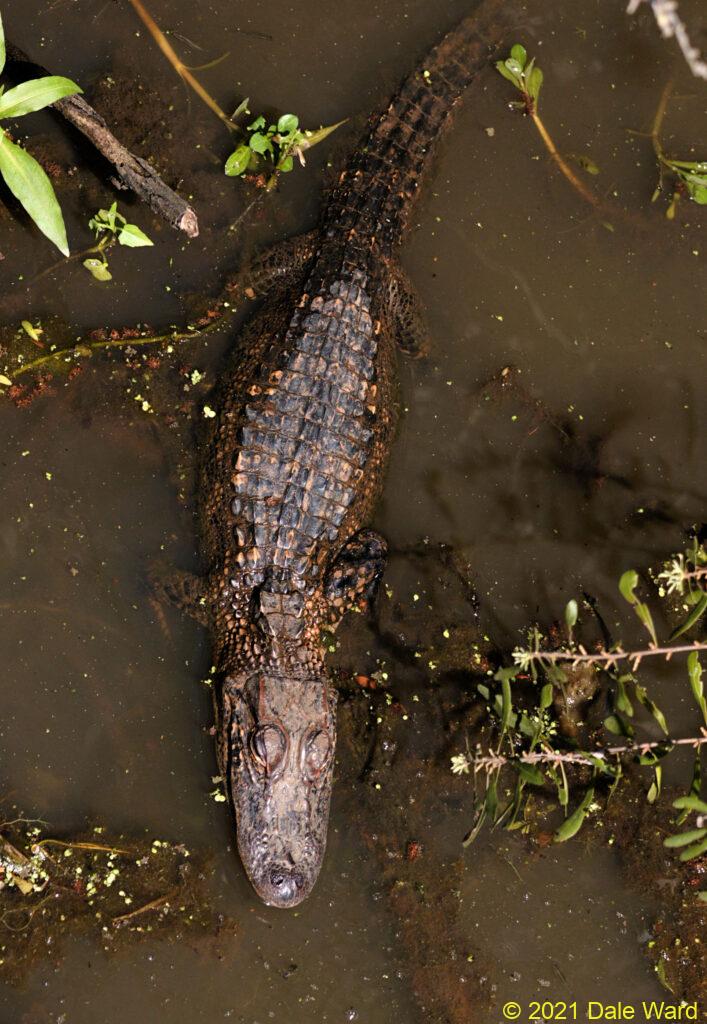 Looking down on an Alligator at Smith Oaks Rookery.
Looking down on an Alligator at Smith Oaks Rookery.
I didn’t notice the Turtle shell scarring at Anahuac Wildlife Refuge, just at Smith Oaks Rookery. Why might that be?
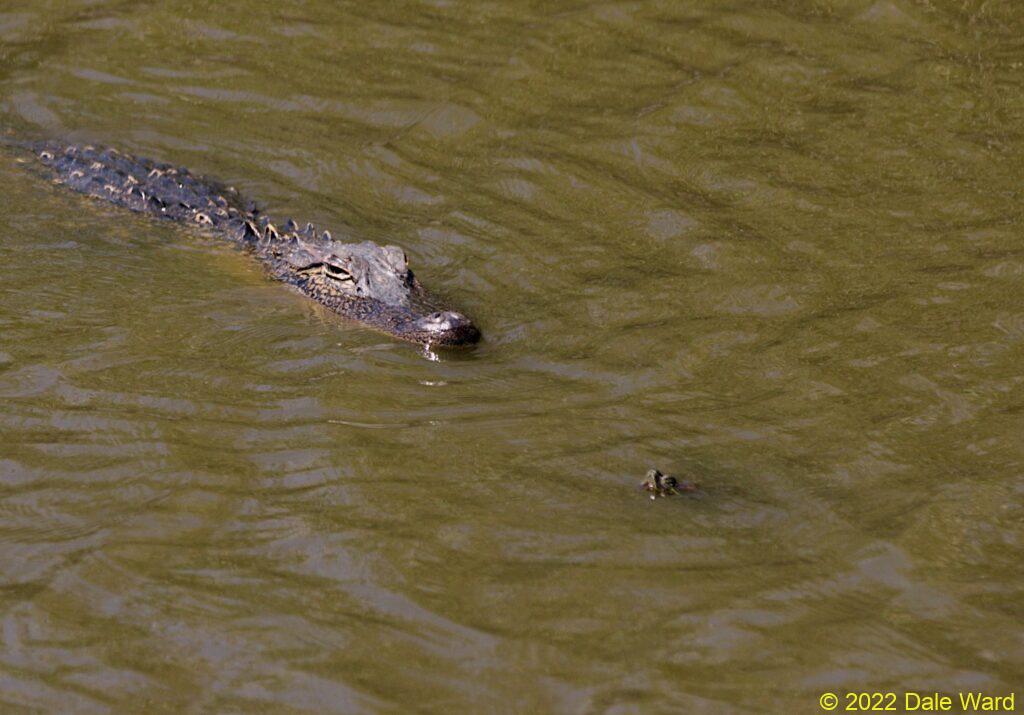 Painted Turtle and Alligator at Anahuac NWR, Texas*
Painted Turtle and Alligator at Anahuac NWR, Texas*
Perhaps because I was able to photograph the Smith Oaks Turtles from nearly directly above, so that it was easier to see the scars. Or perhaps it’s a difference in the Alligators themselves - maybe I didn’t see scarring on the Anahuac Turtles because none of the Anahuac Turtles survived their attacks. Or perhaps the attacks don’t happen as frequently at Anahuac?
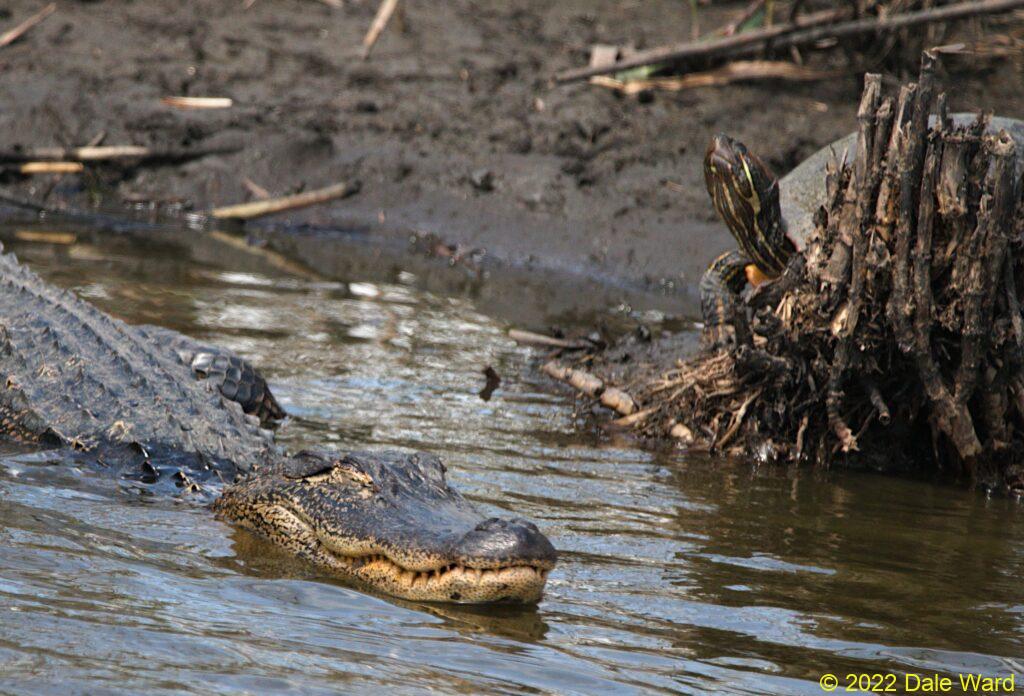 Painted Turtle and Alligator napping at Anahuac NWR, Texas
Painted Turtle and Alligator napping at Anahuac NWR, Texas
So. All of the above is wild conjecture. I didn’t see the Alligators so much as look at the Turtles, not even once. It’s quite possible that there are other naturally occurring phenomena that could create the same markings on the Turtles.
But it’s cool to see these little indications of things that might be going on when we’re not around to watch.